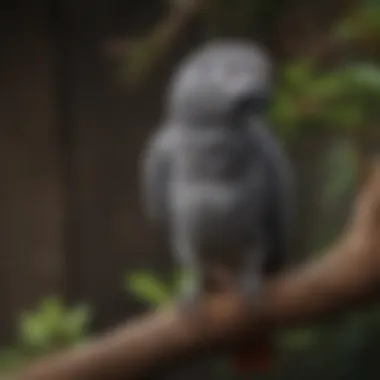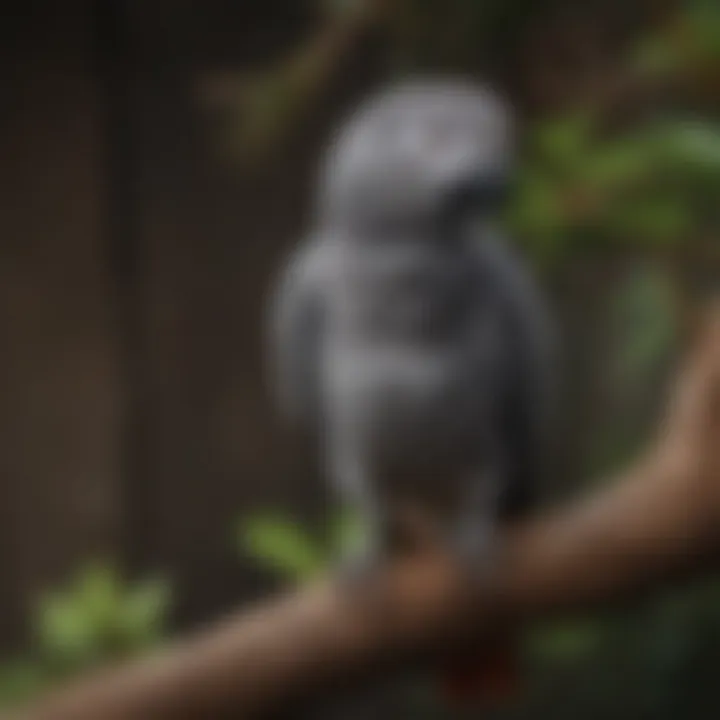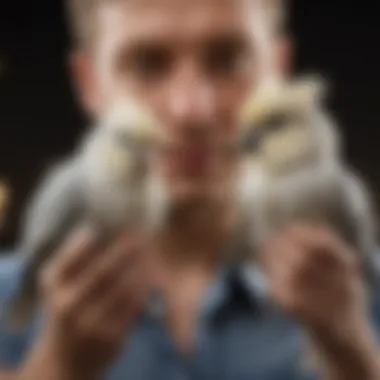Do Pet Birds Fly? Discovering Avian Flight and Care


Intro
Understanding the flying capabilities of pet birds is crucial for their care and well-being. For many species, flight represents not only natural behavior but also essential physical exercise that bolsters their health. This article explores various dimensions of an avian lifestyle. From species-specific instincts to health considerations, owners can learn much about providing an enriching environment suitable for their flying companions.
Next, we will discuss some specific strategies that ensure your feathered friend thrives and takes flight with ease.
Care Tips
Daily Care Routines
Establishing a comprehensive daily care routine fosters a healthy and unhindered environment for pet birds. This includes adequate feeding, monitoring social interactions, and ensuring mental stimulation through play. Each type of bird may have particular needs that merit individual attention. For example, a budgerigar requires a balanced diet alongside social playtime, while a parakeet might need more interactive opportunities for dreaming its full potential.
Cage Setup and Maintenance
The cage serves as a bird's default habitat, making its setup paramount. The size of the cage must fit the species, with enough space to spread wings fully. Regular maintenance is also necessary. Cleaning food bowls, changing water and inspecting for any hazards is a vital daily practice. This not only keeps your bird happy but helps in preventing illness.
Hygiene and Cleaning Practices
A clean environment reduces risks of disease in pet birds. Routine sanitation should include:
- Daily cleaning of food and water dishes.
- Weekly cage cleaning, removing old bedding material.
- Maintaining proper ventilation is key in ensuring o hygiene. Designate a cleaning schedule that can regularly meet these needs.
Seasonal Care Adjustments
As seasons change, so do the care requirements of pet birds. During winter, a bird’s environment may need some extra warmth, while summer may require cooling methods. Keeping an eye on your pet’s behaviors during varying temperatures can also guide care adjustments.
Behavioral Insights
Understanding Bird Body Language
Birds communicate largely through body language. Observing your pet can reveal its feelings. A bird that puffs its feathers or withdraws may be frightened. While a bird stretching its wings or performing small dances indicates happiness.
Common Behavioral Issues and Solutions
In the context of pet owners, several behavioral issues may manifest, including:
- Feather plucking—this can indicate stress or health issues.
- Excessive screaming—could be an attention-seeking behavior. A thoughtful approach can alleviate discomfort. Redirecting attention, featuring engaging distractions, and building consistent interaction habits often yield improvement.
Positive Reinforcement Techniques
Training your bird can strengthen your bond. Utilize positive reinforcement to teach various behaviors, trick and commands. Using treats as reward for their good behavior is helpful in achieving this goal. Over time, patience foster trust and enhances cooperation in performance.
Social Interaction Needs
Birds are often social creatures. Regular interactions play a key role in their emotional well-being. Engaging your pet during playtime is important. Whether they enjoy the company of other birds or human companions, it is crucial to find ways to satisfy these social needs.
Nutrition Guides
Essential Diet Components
Nourishment is a fundamental aspect of pet avian care. A balanced diet typically consists of:
- Seed mix and pellets tailored for the species.
- Fresh fruits and vegetables.
- Nuts—offered in moderation. This assists in fulfilling your birds dietary requriements for growth and overall vitality.
Safe and Toxic Foods
Instead of adopting a trial-and-error approach, knowing safe food alternatives is essential. Be cautious as several common foods can be hazardous including:
- Avocado
- Chocolate
- Caffeine Thus ensuring safe nutrition for your bird is an actionable part of owning one.
Supplements and Treats
When raising birds, treats are useful for training or praise. Nevertheless, treats should not serve as a nutritional replacement. Supplements are available for boosting dietary intake but consult a vet first. Custom tailoring for specific needs and conditions is pivotal for pet fliers.
Feeding Strategies for Different Species
each bird family has nuances in their dietary preferences. Knowing differences elongates basic care into a more involved practice. Understanding these lays groundwork about how your specific bird family member requires your attnetions for tailor strategies essential for longevity.


Wellness and Health
Routine Health Checkups
Just like any other pet, birds benefit substantially from regular health assessments performed by an avian veterinarian. Annual checkups enable early detection of potential issues, averting long-term concerns or excessive treatments.
Identifying Symptoms of Illness
Indirect observation of your pet can yield insight concerning health status. Many behaviors typically signify specific health problems, such as poor appetite, irregular droppings, or sudden changes in plumage. Remaining alert ensures prompt attention when needed.
Preventative Care and Vaccinations
Standard vaccinations critical for almost all pets advice adaptions via avian health. Discussion with your veterinarian could ensure equipped healthcare plan to protect from ranged threats minimizes risks.
Mental and Emotional Well-being
Creating a stress-free environment is equally as vital for avians as it is for mammals. Ensure ample engagement and stimulate activities throughout the day. Enrichment combined with positive methdo help cultivate a happier bird- resulting in more natural flight and wing functioning.
Enriching Activities
Toys and Playtime Ideas
Providing stimulating toys and diverse experiences allows birds to express themselves and minimizes boredom. Regularly checking toys for damage or wear keeps your pet safe. Alternate attractions or offerings add freshness.
Training and Tricks
Teach areas of importance by allowing your bird to learn while fostering alignment between meal goals and informal participation. Such reinforced directories help measure progress under entertaining definitions care.
Outdoor Activities and Interaction
Permitting flight outside encourages natural behavior, although flight risks loom. Enrichment oftentimes increases when considering outdoor tactics to produce bursts unforeseen. Adhere closely to through guidance from caregivers.
DIY Projects for Mental Stimulation
Designing creative activities stimulate brain-related recognition aspect contributes optimal welfare without overwhelemed conditions needs defining. Exploring unique avenues inspires pet birds creatively to manoeuver inherent capacities.
Proper understanding between care techniques levels towers elevate daily routines with benefits shared between great animation journeys road while responsive station near compassionate structures maximized resources.
Having outlined significant player areas addressing avury aircraft dogs seriousness problem through vocal rivalries among assessing posts grateful responsible undertaking warrants fulfillment surrounding component sections ensuring structures throughout life reassured balanced results pleading attained stability content potential. Further insights gainfully find their way reflecting comprehensive carebuilding attitude that forwards opinions hastily needing looping belt background efforts progressously oriented choices regarding nature sets bonded sporting advantages looping clearly defining aspects dedicated hearts along overall transitions centroid reconigny explored required needs connected strongly.
Prologue to Pet Birds and Flight
The exploration of flight in pet birds captivates both breeders and bird owners alike. Understanding avian capabilities is crucial for those who seek to provide a fulfilling life for their feathered companions. This section is important as it sets the groundwork for how various factors influence flight behavior in pet birds. Owners must recognize the implications of a bird's ability to fly, as this often directs how they create living caregivers that accommodate natural instincts, space, and safety needs. A comprehensive view of flight also enhances observations of illness, unsuitability in captivity, or behavioral concerns in their pets.
Defining Pet Birds
Pet birds, broadly labeled as companion avians, range from the small budgerigar to more significant species like macaws. Each type comes with its traits, needs, and behaviors that require attention from owners. Generally, pet birds are species kept for companionship rather than purposes like agriculture or sport. Their behaviors, from easy contact to playful interactions, contrast with wild counterparts, creating an interesting dynamic in captive life.
Several characteristics define pet birds, such as size, color, and vocal ability. Owners often choose these birds based on preferences that align with lifestyle; however, one should acknowledge each species' requirements for adequate socialization, diet, and environment. Understanding species and individual traits is essential for owners who want to provide appropriate care that fosters well-being and positive behavior.
The Importance of Flight
Flight represents an intrinsic aspect of birds’ identity; it is more than simply a means of locomotion. For pet birds, the ability to fly translates into several benefits crucial for their mental and physical health. Most notably, flight stimulates their muscles, encourages agility, and provides chances for exploration, which are aspects needed for optimal emotional health. Not all pet birds have equal capacity or need for flight, dictated often by species, health, and socialization.
Effective flying allows birds to exhibit natural instincts. It improves their confidence, encouraging patterns like social engagement, territory establishment, and stress relief. Contrarily, inadequate space and restrictive environments take away this vital aspect, leading to potential behavioral challenges. Humans must balance controls while offering room for flight and play, creating environments that enable freedom without neglecting the need for safety.
For pet birds, consistent opportunities to exercise their wings can have significant benefits for their well-being.
Thus, understanding how flight affects pet birds informs the essential steps owners take. Whether considering the appropriate would-be environment or practical care considerations, knowing the significance of birds' flight capabilities enables informed decisions to better their lives.
Factors Influencing Flight in Pet Birds
Understanding the various factors that influence flight in pet birds is essential for any owner. Several very important conditions can make a difference in a bird's ability to fly. These conditions include individual species characteristics, overall health, and the environment where the bird lives. Knowing these aspects can help owners provide the right care and supportive environment that encourages natural flight behaviors.
Species Variation
Different species of birds come with their own unique capabilities and instincts when it comes to flying. Some birds, like the American Cockatiel, possess strong flying abilities and need space to spread their wings and practice these skills. In comparison, others, such as some species of finches, might not fly extensively due to their smaller size and natural habitat needs. It's crucial for bird owners to understand the inherent capabilities of their pet species. Recognizing what flight means for each species will create an environment tailored to support their flying potential.


Physical Health
The physical health of a pet bird greatly impacts its ability to fly. A bird that suffers from diseases or injuries may not be capable of flight, not only hurting itself but also affecting its quality of life. Monitoring a bird’s health regularly through veterinary check-ups ensures it stays fit enough for flight. Validation of diet, incorporating sufficient nutrients, plays a role too. A balanced diet provides the vital strength needed for flying, by keeping muscles and bones in good condition. Evaluate there condition frequently for any signs of illness or lack of energy.
Environment and Space
The environment in which a pet bird exists is significant for its flight capabilities. Birds require adequate space to take off, land, and fly freely. When confined to small cages, birds can feel restricted, and their natural behaviors decrease. It is beneficial to create an environment where the bird can experience freedom and mobility. Open areas safe for flight help a bird grow healthier and maintain its instincts effectively. Proper cage design should also combine climbing opportunities with flight space, promoting both behavior forms.
Creating the right environment enriched with opportunities to move is essential for enhancing a bird’s mental and physical well-being.
Additionally, distractions or dangers should also be minimized. Obstacles like fans, dangling wires, or hazards can pose threats to free flight. Safety, combined with suitable progression plans for increases in flight time, significantly influences the overall flying experience.
Crafting the lifestyle around several factors can ultimately establish how well a pet bird can fly. Each consideration functions distinctly yet connects within a mutual goal: the overall well-being of the bird through flight.
Common Pet Bird Species and Their Flying Abilities
Understanding the flying abilities of various pet bird species is critical for owners who wish to foster a healthy environment that supports their birds’ natural instincts. By recognizing how different species behave in flight and their needs, owners can tailor care practices that fulfill these essential aspects of their pets’ lives. This section discusses three popular pet bird species: budgerigars, cockatiels, and parakeets. Each possesses distinct characteristics and unique flight behavior that owners must understand for optimal care.
Budgerigar Characteristics
Budgerigars, commonly known as budgies, are small parrots originating from Australia. Their natural habitat includes open forests and grasslands, where they are accustomed to socializing in flocks. This behavior directly influences their flying ability.
- Flight Capacity: Budgies are known for their agility in the air. They can perform sharp turns, rapid movements, and long glides that showcase their once-lively existence in the wild. When trained, they enjoy short but high-energy flights of agility with effortless grace.
- Wing Structure: Their wing structure, featuring long feathers for flight, allows for powerful wing beats. They typically keep their tails spread in flight, aiding in balance and control.
- Individual Needs: Owners must consider each budgie's comfort and confidence levels regarding flight. Some birds might prefer controlled environments, whereas more daring budgies might relisk enjoy searching for open space. Educating oneself about individual personality traits can lead to successful training and flight practices.
Cockatiels and Their Flights
Cockatiels, with their charming crests and distinct whistling abilities, belong to the cockatoo family. These birds exhibit unique flight behavior influenced by their social nature and physical adaptations that favor long flight.
- Wing Span: Cockatiels have broader wings than many smaller birds, allowing them to glide gracefully for longer durations. In flight, they appear calm yet jovial, reflecting their playful dispositions.
- Navigational Skills: They navigate by visual perception, with keen eyesight, enabling precise landings. Therefore, an appropriately designed space for flying consists of clear paths and areas to perch near beloved objects.
- Training Considerations: Effective flight training requires a bond between the bird and owner. This bond promotes comfort and reduces anxiety during takeoff and landing examples, fostering safety and encouraging natural flying instincts.
Parakeets: Flight Patterns and Behavior
Parakeets, like the English and Indian species, exhibit unique and entertaining flight behavior, showcasing their communal instincts. Thoroughly understanding their flight patterns helps create enriching environments for these lively birds to flourish.
- Behavioral Traits: Parakeets typically flourish in communal surroundings. It is essential to account for their social nature when providing enough flight space. Birds prefer an environment where they can perch and rest between flights, mimicking their social behaviors in nests or communal roosts.
- Flight Path Preference: These birds love to maintain a circular flight path, back and forth between different elevations and perches. They often dive and rise, engaging others within their flocks.
- Perch Availability: Providing diverse and adjustable perches enables them to have areas to explore and practice their flight patterns without exhaustion or risk, allowing them to exercise freely while imitating their natural environments.
In sum, comprehending the type of pet bird you have and their specific flying abilities leads to a more enriching life for your feathery companions. Each species comes with its idiosyncratic traits and requirements that require careful consideration.
"Flight is not just an act of movement but a demonstration of instinct that must be accommodated in pet bird care."
Exploring these species enables pet owners to cater to their natural flight-infused needs in ways that enhance their quality of life.
Creating a Suitable Flight Environment
Creating an adequate environment for pet birds is vital. Environments facilitate their natural behaviors. Birds are instinctively built to fly; thus, the design of their surroundings should accommodate their flying capabilities. When creating a suitable flight environment, factors such as spaces, safety, and stimulation play significant roles.
Aviary Design Considerations
A well-designed aviary is more than a cage. It should provide enough free space for birds to fly comfortably. Think about the dimensions of the aviary; taller aviaries promote upward flight, while wider spaces allow for horizontal movements. Essential elements like perches should be strategically placed, providing opportunities for stretching and landing.
When selecting materials, sturdiness is key. Use non-toxic and safe materials. Furthermore, ventilation is crucial. Proper airflow contributes to the overall health of pet birds. Indoor bird owners may want to design a space with natural light. Sunlight offers beneficial UV rays, necessary for a bird's well-being. In addition, including various levels for climbing and different textures enriches the bird's habitat.
Safety Measures for Flying Birds
Safety has to be a priority when allowing birds to fly. The environment should guard against harmful hazards. Here are crucial guidelines:
- Secure Windows and Doors: Use screens or bars to prevent accidental escapes.
- Remove Toxic Plants: Identify any plants in the area that might be poisonous to birds.
- Monitor Other Pets: Ensure that other pets, like dogs or cats, cannot access flying birds.
- Proper Feed Area: Designate feeding stations away from landing areas. Birds should have easy access to their food without the threat of falling.
A blockquote summarizes key awareness:
Health Considerations for Flying Birds
Health is a crucial element for the well-being of flying birds. Their ability to exhibit natural behaviors, including flying, is closely tied to their health. Regular check-ups, a balanced diet, and adequate exercise all play a vital role in maintaining their fitness. It ensures not only longevity but also enhances their quality of life, allowing them to thrive in captivity.
Regular Health Check-ups
Regular health check-ups are integral to ensuring that pet birds remain healthy. These visits allow avian veterinarians to identify potential health issues before they become serious. For example, many birds can hide their illnesses well. By the time an owner notices symptoms, crucial time may be lost in treatment. Annual examinations, or biannual for older birds, can address issues such as feather problems or respiratory infections.


- Weight Monitoring: One key aspect of these check-ups is weight management. Overweight birds may struggle to fly effectively. Monitoring weight helps the owner adjust the diet accordingly.
- Vaccinations: Some species may require routine vaccinations. Consulting a vet can provide guidance on necessary vaccines based on species and environment. They also perform necessary health screening that ensures everything is fine.
Preventive health care is best care. Timely intervention is necessary for a long, healthy life.
Dietary Impact on Flight Capability
Proper diet significantly influences the flying ability of pet birds. A well-balanced diet provides the critical nutrients birds need to maintain muscle mass, energy levels, and overall health. Diets that lack essential nutrients can lead to weakness and reduced flight ability.
A varied diet includes:
- Pellets: High-quality pellets should be a staple, fortified with vitamins, minerals, and proteins.
- Fresh Fruits and Vegetables: These enhance hydration and provide important vitamins. For example, leafy greens like kale or dark leafy vegetables contribute important nutrients that help birds with energy.
- Seeds: While some can contain important fats, seeds alone shouldn't make up the entire meal. They are often high in fat and low in much needed nutrition.
Exercise and Its Role in Flight
Physical activity is essential for maintaining a bird’s flying abilities. Not only does exercise help strengthen their muscles, but it also promotes cardiovascular health. Flying regularly allows birds to build up endurance, making it easier for them to maneuver in the air when needed.
- Free Flight Time: Allowing birds to fly freely in a safe space enhances their physical condition. Owners should create an environment that encourages flight, preventing boredom and promoting health.
- Scheduled Play and Training: Engaging in scheduled flying sessions helps. Birds appreciate structured exercises. Strengthening their wings through such activities springs action into their muscles and leads to better multifunctional flying.
- Obstacle Courses: Using different perches and toys can add levels of fun and challenge, further encouraging them to fly while exercising.
A focus on these health factors creates happier, healthier pet birds poised for optimal flight capabilities.
Training Techniques for Encouraging Flight
Training techniques play a significant role in ensuring pet birds reach their flying potential while also fostering their overall well-being. Effective training can provide your bird with physical engagement and mental stimulation. Flight is not just an instinctive behavior; it is a necessity for many species, contributing positively to both their physical health and mental posture. Understanding various training methods helps pet owners cater to the specific needs of their birds, promote flight ability, and enhance the bond between humans and birds.
Basic Flying Commands
Introducing basic flying commands helps the bird understand what is expected during interactions. Simple commands such as come and stay can enhance flight safety and reliability when engaging your pet bird.
- Start Slow: Initiate training sessions in a calm area free from distractions.
- Clear Instructions: Use short and clear phrases
- Consistent Practice: Regular training boosts familiarity with commands over time.
- Refining Skills: Gradually teach more complex commands as your bird becomes comfortable with the basics.
Setting a routine that mixes these simple commands with play can keep your bird motivated and ready to fly.
Building Trust with Your Bird
Trust forms the core of healthy interactions between birds and their humans. When a bird trusts its owner, it may feel more secure and comfortable to fly. This trust is built through shared experiences, gentle handling, and positive engagement.
- Patience is Key: Allow time for your bird to adjust to new commands without rushing.
- Spend Time Together: Regular and accountable interactions lead to improved comfort levels.
- Observe Behavior: Watch for tail whistles, eye-pinching, or wing stretching, which may demonstrate eagerness to fly towards you.
- Positive Interactions: Create indirect training methods like having fun with toys or treats while staying close to the bird’s surroundings.
Fostering trust leads to confident flight, contributing to the pet bird's choice to leave safety for new perches.
Utilizing Positive Reinforcement
Positive reinforcement comprises rewarding desirable behaviors to encourage repeated actions. This method can motivate and create joyful anticipation during training.
- Select Favorite Treats: Identify which treats your bird loves the most to effectively reinforce good behaviors.
- Immediate Praise: Offer treats or verbal praise right after the bird completes even a small action correctly.
- Gradual Challenges: As confidence builds, introduce more complex flying tasks, implementing rewards for successful attempts.
- Celebrate Efforts: Recognize minor successes. Positive feedback makes learning enjoyable.
By incorporating positive reinforcement, owners can effectively promote enhanced flying skills, while ensuring the emotional well-being of their birds.
Effective training enhances not only flying ability but also the emotional bonds between pet birds and their owners.
Closure: Balancing Flight and Care
The concluding section of this article emphasizes the intricate relationship between a pet bird's flying abilities and its overall well-being. Addressing the needs of pet birds goes beyond just understanding their natural aptitude for flight. It involves a holistic view of their species, health, environment, and the specific interactions they have with their caregivers. Articulating these elements clearly can lead to informed decisions that ultimately support the vitality and happiness of the bird.
Evaluating Individual Bird Needs
Every bird is unique, and that individuality plays a crucial role in flight capabilities. Factors such as age, species, and previous conditions undergo integration when determining their specific needs. Parrots, for instance, vary significantly between species in their flight patterns and behaviors. Owners must assess their bird's specific circumstances, including:
- Physical Health: Are there existing medical conditions that might affect flight capability?
- Space Needs: Is the aviary or cage large enough to allow cruising and landing maneuvers?
- Social Factors: Does the bird have sufficient social interaction with humans and other pets?
A tailored approach ensures that caretakers meet their birds’ individual requirements, enabling them to express their natural behaviors like flying.
Long-Term Considerations for Flight
Ensuring longevity in both flight and care needs continual evaluation and planning. As pet birds age, their needs may shift. Preparation for these changes helps in adjusting care routines suited for senior birds. Issues to consider would include reduction in energy levels, changes in feather condition, and balancing social dynamics with affection from owners.
Important Factors:
- Routine Adaptability: An evolving diet and safety measures should evolve over time.
- Veterinary Care: Regular health checks are crucial in keeping birds physically capable of flight.
- Environmental Changes: Moving to a new location or alterations in space can impact how highly active a bird remains.
A thoughtful approach leads caregivers to establish a nurturing environment that balances freedom and care, contributing effectively to their pet bird's quality of life.
Evaluating every aspect from the bird's individual needs to contemplating long-term challenges ultimately fosters a successful lifetime relationship. Being mindful of these will create a fulfilling experience not just for the bird, but for the owner as well.















